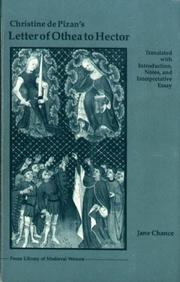| Listing 1 - 3 of 3 |
Sort by
|
Book
Year: 1970 Publisher: Oxford : Oxford University Press,
Abstract | Keywords | Export | Availability | Bookmark
 Loading...
Loading...Choose an application
- Reference Manager
- EndNote
- RefWorks (Direct export to RefWorks)

ISBN: 0859914402 Year: 1997 Volume: *2 Publisher: Suffolk (UK) : D. S. Brewer,
Abstract | Keywords | Export | Availability | Bookmark
 Loading...
Loading...Choose an application
- Reference Manager
- EndNote
- RefWorks (Direct export to RefWorks)
Christine de Pisan --- Women and literature --- France --- History --- CHRISTINE DE PISAN, VERS 1363-1430 --- EPITRE D'OTHEA A HECTOR

ISBN: 0472113232 9780472113231 Year: 2003 Publisher: Ann Arbor, MI : University of Michigan Press,
Abstract | Keywords | Export | Availability | Bookmark
 Loading...
Loading...Choose an application
- Reference Manager
- EndNote
- RefWorks (Direct export to RefWorks)
The material properties of late medieval manuscripts testify to the power of visual images to shape both the reading experience and the reader. Early fifteenth century Paris saw a proliferation of luxury manuscripts whose luminous illustrations situate the reader as spectator, and Christine de Pizan's Epistre Othea exemplifies the power of visual representation to shape the medieval reading experience. According to the rhetoric of the Othea, the body, character, and soul of the reader are formed as a result of simultaneously viewing the images and reading the text. In Myth, Montage, and Visuality in Late Medieval Manuscript Culture Marilynn Desmond and Pamela Sheingorn analyze the ways in which Othea manuscripts display classical myths for late medieval humanist, chivalric, and Christian readers. Desmond and Sheingorn's innovative study draws extensively on film theory and its notions of spectatorship to explore the ethical implications of viewing illustrated manuscripts for the medieval reader. Focusing particularly on the twin manuscripts of the Othea in the Duke's manuscript and the Queen's manuscript, the authors suggest that pre-modern and post-modern cultures share a predilection for the cinematic arrangement of knowledge in a montage format in which meaning derives from unexpected juxtapositions. Desmond and Sheingorn's interdisciplinary endeavor sheds new light on the study of medieval women writers, the medieval reception of classical myth, manuscript studies and codicology, gender and sexuality, and theoretical approaches to visual cultures, particularly the value of film theory for the study of pre-modern cultures.
Manuscripts. Epigraphy. Paleography --- Christine de Pizan --- Christine, --- 091 CHRISTINE DE PISAN --- 091.31 <44> --- 091.31:7.04 --- Handschriftenkunde. Handschriftencatalogi--CHRISTINE DE PISAN --- Verluchte handschriften--Frankrijk --- Verluchte handschriften: iconografie --- Christine de Pisan --- 091.31:7.04 Verluchte handschriften: iconografie --- 091.31 <44> Verluchte handschriften--Frankrijk --- 091 CHRISTINE DE PISAN Handschriftenkunde. Handschriftencatalogi--CHRISTINE DE PISAN --- De Pizan, Christine --- de Pisan, Christine --- Christine, - de Pisan, - ca. 1364-ca. 1431. - Epitre d'Othea a Hector --- CHRISTINE DE PISAN, VERS 1363-1430 --- EPITRE D'OTHEA
| Listing 1 - 3 of 3 |
Sort by
|

 Search
Search Feedback
Feedback About UniCat
About UniCat  Help
Help News
News